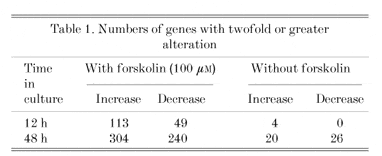The cytotrophoblast cell line BeWo can be induced to syncytialise in vitro by forskolin (Wice et al. 1990). We have used Affymetrix GeneChip expression technology to study this process. BeWo cells that were predominantly mononucleate (passage number approximately 40, a generous gift from Dr S. Greenwood) were cultured in the presence or absence of forskolin and harvested before treatment, and then after 12 and 48 h. Total RNA was extracted from the cells, reverse transcribed into cDNA and and biotinylated cRNA prepared by in vitro transcription. The labelled-cRNA target was then hybridised overnight to a U95Av2 GeneChip possessing specific oligonucleotide probe sets to over 12 000 human genes. After washing and staining the arrays they were scanned and the fluorescent intensity used to compare mRNA levels for the genes represented on the array. Detectable levels of signal were found on average for 44 % of the total number of genes assayed. The correlation coefficient for the level of expression of independent replicates was 0.99. Table 1 shows the numbers of genes with a twofold or greater alteration (increased or decreased) in expression during culture with or without forskolin treatment.
It is apparent from Table 1 that forskolin induces a number of specific alterations in gene expression. The pattern of changes observed following forskolin treatment allowed clustering of expression profiles into at least five categories. We have used gene function to classify genes within each cluster. Among the genes with increased expression following forskolin treatment were many required for intercellular communication (such as placental specific peptide hormones) and intracellular metabolism (such as cholesterol side chain cleavage enzyme). This matches the known stimulation of hormone production induced by forskolin in BeWo cells (Pattillo et al. 1968). Additionally disintegrins (ADAM19) and CD9 (proteins involved elsewhere in cell fusion) have markedly increased expression levels very early following forskolin exposure. Since the increase in their expression precedes morphological fusion of BeWo cells these molecules may be causally involved in this process. Further analysis of these data and expression profiling in general, will be able to contribute to understanding the formation of the placental syncytiotrophoblast.

